spare tire TOYOTA YARIS 2019 Owners Manual (in English)
[x] Cancel search | Manufacturer: TOYOTA, Model Year: 2019, Model line: YARIS, Model: TOYOTA YARIS 2019Pages: 600, PDF Size: 6.11 MB
Page 5 of 600

5
1
8 7
6 4 3
2
YARIS SEDAN_OM_OM99S50z_(U)
5
5-1. Essential InformationIntroduction ....................... 432
5-2. Scheduled Maintenance Maintenance Monitor......... 434
5-3. Owner Maintenance Owner Maintenance Precautions ..................... 437
Hood.................................. 439
Engine Compartment Overview ......................... 441
Engine Oil.......................... 442
Engine Coolant.................. 445
Brake/Clutch Fluid ............. 448
Window Washer Fluid ....... 449
Body Lubrication ............... 450
Wiper Blades ..................... 451
Battery ............................... 454
Key Battery Replacement ................... 456
Tires .................................. 459
Light Bulbs ........................ 465
Fuses ................................ 475
5-4. Appearance Care Exterior Care ..................... 482
Interior Care ...................... 490 6-1. Parking in an Emergency
Parking in an Emergency ...................... 496
6-2. Flat Tire Spare Tire and Tool Storage ............................ 497
Changing a Flat Tire .......... 501
6-3. Battery Runs Out Jump-Starting .................... 511
6-4. Emergency Starting Starting a Flooded Engine ............................. 515
Push-Starting ..................... 516
6-5. Overheating Overheating ....................... 517
6-6. Emergency Towing Towing Description ............ 519
Tiedown Hooks .................. 520
6-7. Warning/Indicator Lights and Warning Sounds
If a Warning Light Turns On or Flashes .................. 522
Message Indicated on Display............................. 533
Warning Sound is Activated.......................... 535
6-8. When Trunk Lid Cannot be Opened
When Trunk Lid Cannot be Opened....................... 539
5Maintenance and Care6If Trouble Arises
Page 139 of 600
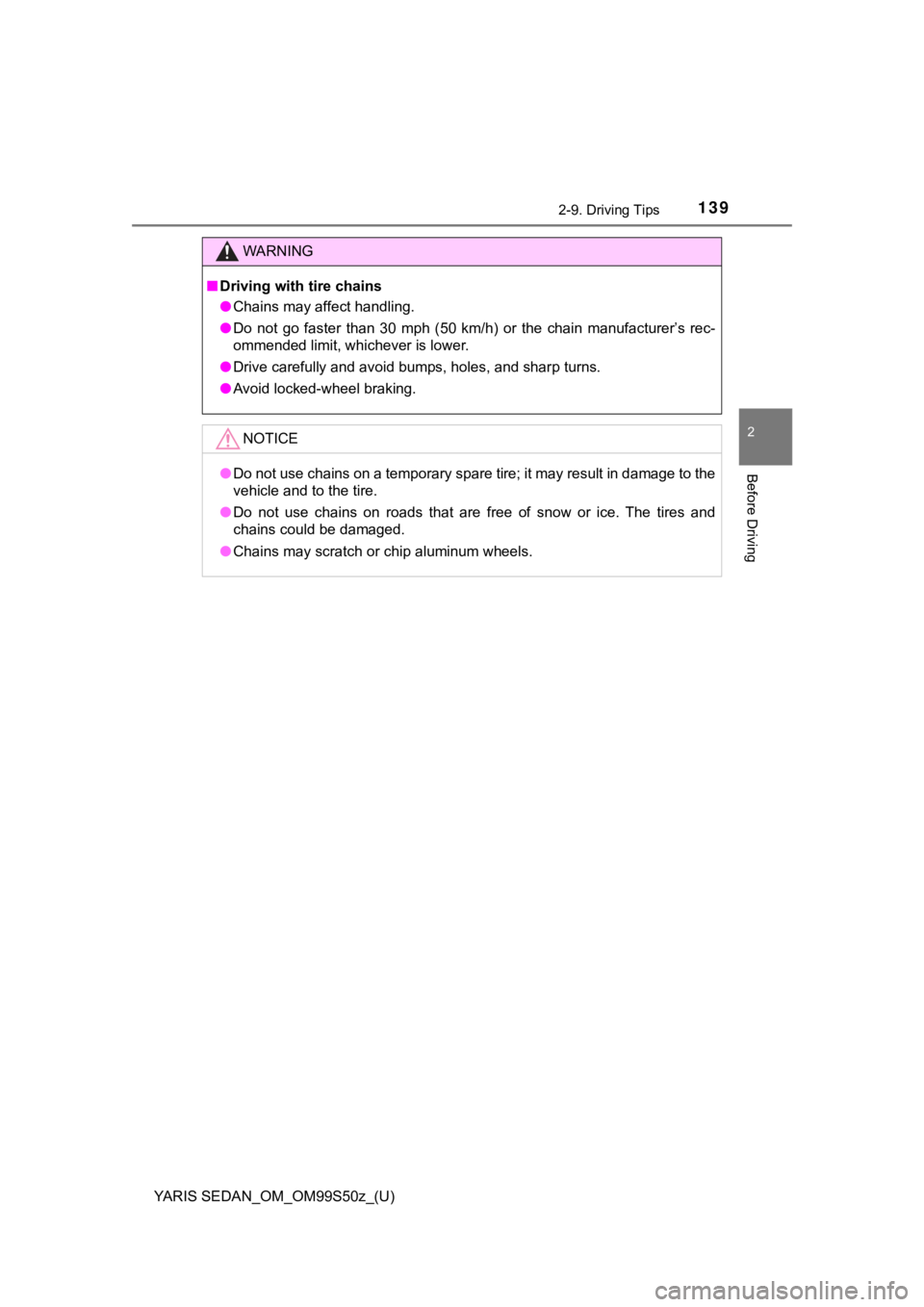
YARIS SEDAN_OM_OM99S50z_(U)
1392-9. Driving Tips
2
Before Driving
WARNING
■Driving with tire chains
● Chains may affect handling.
● Do not go faster than 30 mph (50 km/h) or the chain manufacture r’s rec-
ommended limit, whichever is lower.
● Drive carefully and avoid bumps, holes, and sharp turns.
● Avoid locked-wheel braking.
NOTICE
●Do not use chains on a temporary spare tire; it may result in d amage to the
vehicle and to the tire.
● Do not use chains on roads that are free of snow or ice. The ti res and
chains could be damaged.
● Chains may scratch or chip aluminum wheels.
Page 207 of 600
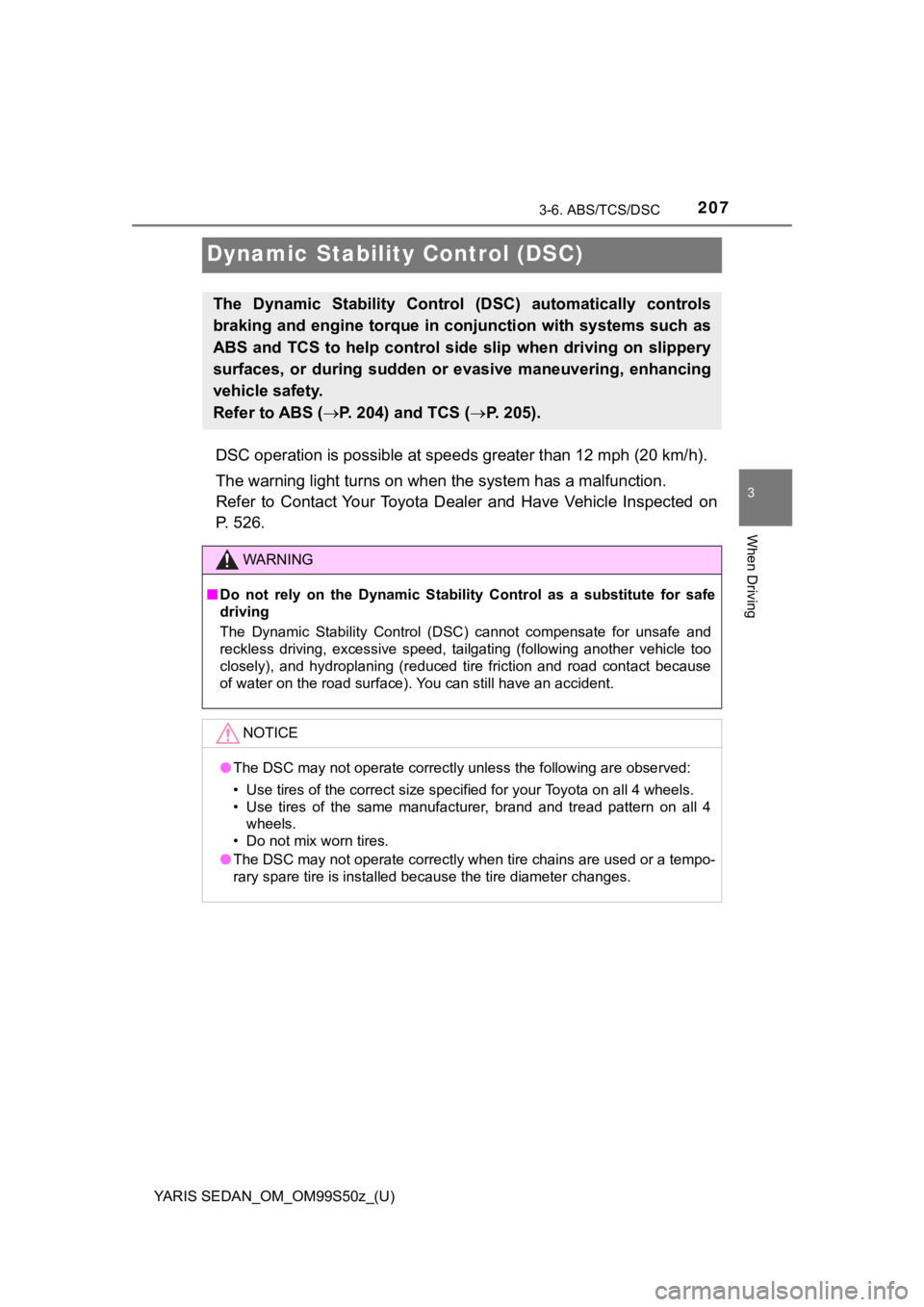
207
YARIS SEDAN_OM_OM99S50z_(U)
3-6. ABS/TCS/DSC
3
When Driving
Dynamic Stability Control (DSC)
DSC operation is possible at speeds greater than 12 mph (20 km/h).
The warning light turns on when the system has a malfunction.
Refer to Contact Your Toyota Dealer and Have Vehicle Inspected on
P. 526.
The Dynamic Stability Control ( DSC) automatically controls
braking and engine torque in c onjunction with systems such as
ABS and TCS to help control si de slip when driving on slippery
surfaces, or during sudden or e vasive maneuvering, enhancing
vehicle safety.
Refer to ABS ( P. 204) and TCS ( P. 205).
WARNING
■Do not rely on the Dynamic Stabil ity Control as a substitute for safe
driving
The Dynamic Stability Control (DSC) cannot compensate for unsaf e and
reckless driving, excessive speed, tailgating (following anothe r vehicle too
closely), and hydroplaning (reduced tire friction and road cont act because
of water on the road surface). You can still have an accident.
NOTICE
● The DSC may not operate correctly unless the following are obse rved:
• Use tires of the correct size specified for your Toyota on all 4 wheels.
• Use tires of the same manufacturer, brand and tread pattern on all 4 wheels.
• Do not mix worn tires.
● The DSC may not operate correctly when tire chains are used or a tempo-
rary spare tire is installed because the tire diameter changes.
Page 220 of 600

220
YARIS SEDAN_OM_OM99S50z_(U)
3-10. Active Safety System
WARNING
■Do not rely on the Smart City B rake Support System (SCBS) as a sub-
stitute for safer driving
The Smart City Brake Support (SCBS) system cannot compensate for
unsafe and reckless driving, excessive speed, tailgating (follo wing another
vehicle too closely), and driving on slippery roads such as wet , snowy, and
icy roads (reduced tire friction and road contact because of wa ter on the
road surface). You can still have an accident.
■ Do not rely completely on the Smart City Brake Support (SCBS) s ystem
● The Smart City Brake Support (SCBS) system is only designed to reduce
damage in the event of a collision. Over reliance on the system leading to
the accelerator pedal or brake pedal being mistakenly operated could
result in an accident.
● The Smart City Brake Support (SCBS) is a system which operates in
response to a vehicle ahead. The system may not be able to detect or
react to two-wheeled vehicles or pedestrians.
● The laser sensor for the Smart City Brake Support (SCBS) system is
installed near the rearview mirror. To assure the correct opera tion of the
Smart City Brake Support (SCBS), heed the following cautions.
• Do not apply stickers to the surface of the windshield near the laser sensor (including transparent stickers). Otherwise, the laser s ensor
may not be able to detect vehicles ahead which could result in an acci-
dent.
• Do not apply coating agent to the windshield. Otherwise, the l aser sen-
sor may not be able to detect vehicles or obstructions in front which
could result in an accident.
• Do not disassemble the laser sensor.
• If cracks or damage caused by flying gravel or debris is visib le near
the laser sensor, stop using the Smart City Brake Support (SCBS )
system immediately and have your vehicle inspected by your Toyo ta
dealer. If the vehicle continues to be driven with cracks or sc ratch
marks left on the windshield near the laser sensor, the system may
operate unnecessarily and cause an unexpected accident.
Refer to Stopping The Smart City Brake Support (SCBS) System
Operation on P. 222.
• When replacing the windshield wi pers or windshield, consult your
Toyota dealer.
● The laser sensor includes a function for detecting a soiled windshield and
informing the driver, however, depending on the conditions, it may not
detect plastic shopping bags, ice or snow on the windshield. In such
cases, the system cannot accurately determine a vehicle ahead a nd may
not be able to operate normally. Always drive carefully and pay attention to
the road ahead.
Page 232 of 600

232
YARIS SEDAN_OM_OM99S50z_(U)
3-12. Tire Pressure Monitoring System
NOTICE
●Each tire, including the spare (if provided), should be checked monthly
when cold and inflated to the inflation pressure recommended by the
vehicle manufacturer on the vehi cle placard or tire inflation pressure
label. (If your vehicle has tires of a different size than the size indicated
on the vehicle placard or tire i nflation pressure label, you sh ould deter-
mine the proper tire inflati on pressure for those tires.)
As an added safety feature, your vehicle has been equipped with a tire
pressure monitoring system (TPMS ) that illuminates a low tire pres-
sure telltale when one or more of your tires is significantly u nder-
inflated. Accordingly, when the low tire pressure telltale illuminates,
you should stop and check your tires as soon as possible, and i nflate
them to the proper pressure. Driving on a significantly under-i nflated
tire causes the tire to overheat and can lead to tire failure. Under-infla-
tion also reduces fuel efficiency and tire tread life, and may affect the
vehicle’s handling an d stopping ability.
Please note that the TPMS is not a substitute for proper tire m ainte-
nance, and it is the driver’s r esponsibility to maintain correc t tire pres-
sure, even if under-inflation has not reached the level to trig ger
illumination of the TPMS lo w tire pressure telltale.
Your vehicle has also been equipped with a TPMS malfunction ind ica-
tor to indicate when the syste m is not operating properly.
The TPMS malfunction indicator i s combined with the low tire pressure
telltale. When the system detects a malfunction, the telltale will flash
for approximately one minute an d then remain continuously illumi-
nated. This sequence will contin ue upon subsequent vehicle star t-ups
as long as the malfunction exists . When the malfunction indicator is
illuminated, the system may not be able to detect or signal low tire
pressure as intended. TPMS malfunctions may occur for a variety of
reasons, including the installation of replacement or alternate tires or
wheels on the vehicle that prevent the TPMS from functioning pr operly.
Always check the TPMS malfunction telltale after replacing one or
more tires or wheels on your veh icle to ensure that the replacement or
alternate tires and wheels allow the TPMS to continue to functi on prop-
erly.
●To avoid false readings, the system samples for a little while before
indicating a problem. As a res ult it will not instantaneously register a
rapid tire deflation or blow out.
Page 234 of 600
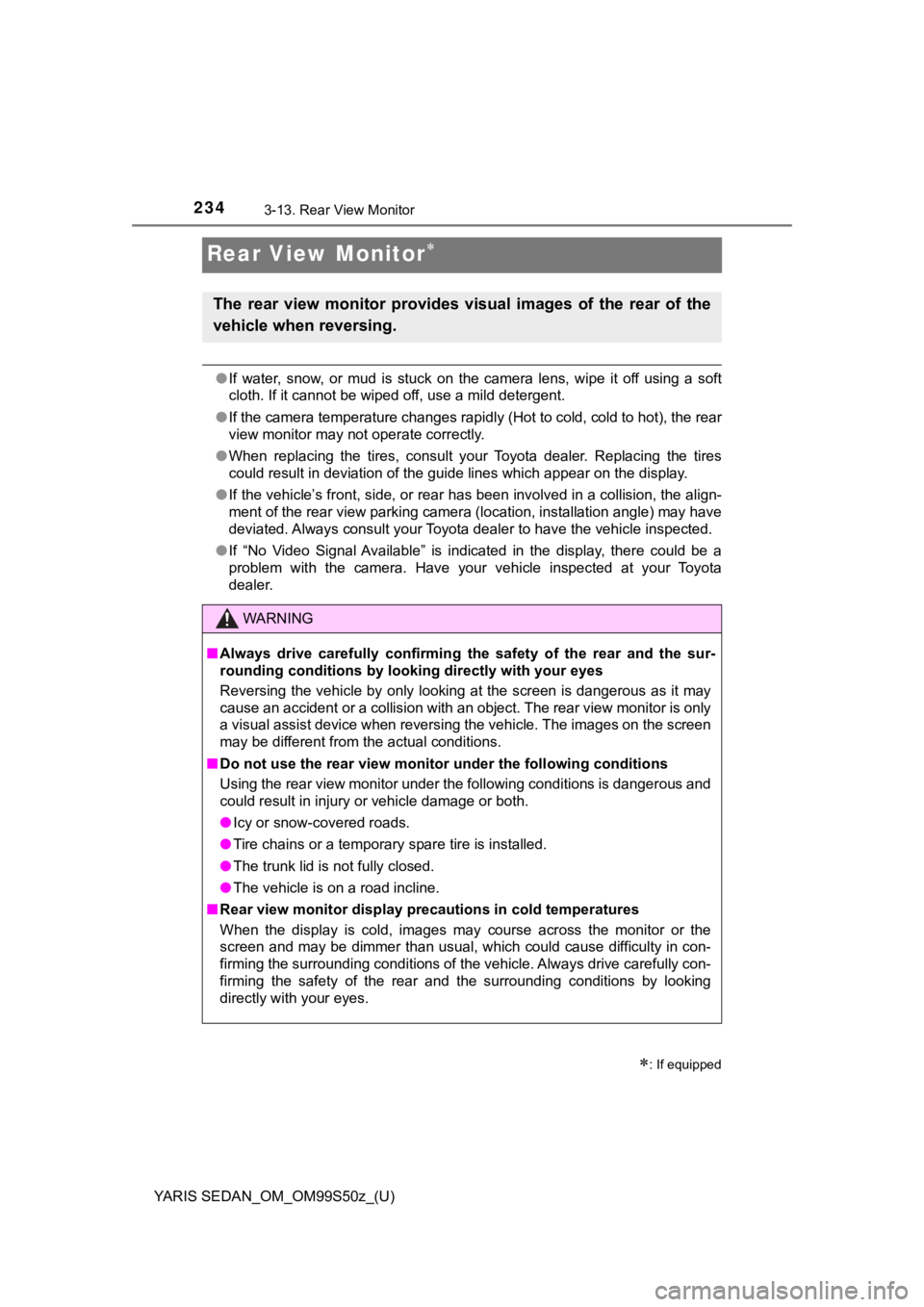
234
YARIS SEDAN_OM_OM99S50z_(U)
3-13. Rear View Monitor
Rear View Monitor
●If water, snow, or mud is stuck on the camera lens, wipe it off using a soft
cloth. If it cannot be wiped off, use a mild detergent.
● If the camera temperature changes rapidly (Hot to cold, cold to hot), the rear
view monitor may not operate correctly.
● When replacing the tires, consult your Toyota dealer. Replacing the tires
could result in deviation of the guide lines which appear on th e display.
● If the vehicle’s front, side, or rear has been involved in a collision, the align-
ment of the rear view parking camera (location, installation an gle) may have
deviated. Always consult your Toyota dealer to have the vehicle inspected.
● If “No Video Signal Available” is indicated in the display, the re could be a
problem with the camera. Have your vehicle inspected at your To yota
dealer.
: If equipped
The rear view monitor provides vi sual images of the rear of the
vehicle when reversing.
WARNING
■ Always drive carefully confirming the safety of the rear and the sur-
rounding conditions by looking directly with your eyes
Reversing the vehicle by only looking at the screen is dangerous as it may
cause an accident or a collision with an object. The rear view monitor is only
a visual assist device when reversing the vehicle. The images o n the screen
may be different from the actual conditions.
■ Do not use the rear view monitor under the following conditions
Using the rear view monitor under the following conditions is d angerous and
could result in injury or vehicle damage or both.
● Icy or snow-covered roads.
● Tire chains or a temporary spare tire is installed.
● The trunk lid is not fully closed.
● The vehicle is on a road incline.
■ Rear view monitor display pr ecautions in cold temperatures
When the display is cold, images may course across the monitor or the
screen and may be dimmer than usual, which could cause difficulty in con-
firming the surrounding conditions of the vehicle. Always drive carefully con-
firming the safety of the rear and the surrounding conditions b y looking
directly with your eyes.
Page 459 of 600
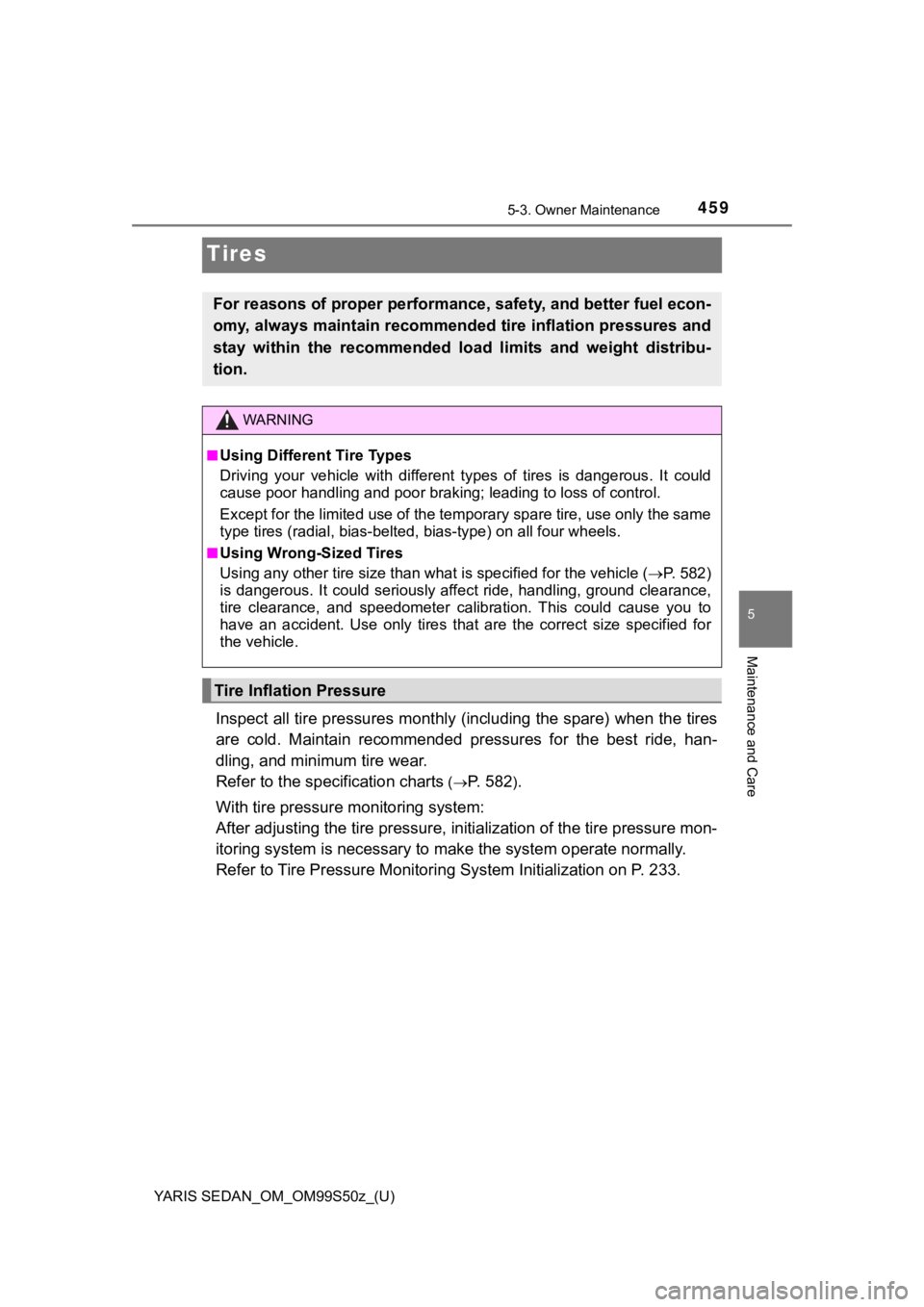
459
YARIS SEDAN_OM_OM99S50z_(U)
5-3. Owner Maintenance
5
Maintenance and Care
Tires
Inspect all tire pressures monthly (including the spare) when the tires
are cold. Maintain recommended pressures for the best ride, han -
dling, and minimum tire wear.
Refer to the spec ification charts
(P. 5 8 2).
With tire pressure m onitoring system:
After adjusting the tire pressur e, initialization of the tire p ressure mon-
itoring system is necessary to m ake the system operate normally .
Refer to Tire Pressure Monitorin g System Initialization on P. 233.
For reasons of proper performan ce, safety, and better fuel econ-
omy, always maintain recommended tire inflation pressures and
stay within the recommended load limits and weight distribu-
tion.
WARNING
■Using Different Tire Types
Driving your vehicle with differ ent types of tires is dangerous . It could
cause poor handling and poor bra king; leading to loss of control.
Except for the limited use of the temporary spare tire, use onl y the same
type tires (radial, bi as-belted, bias-type) on all four wheels.
■Using Wrong-Sized Tires
Using any other tire size than wh at is specified for the vehicle (P. 5 8 2 )
is dangerous. It could seriously affect ride, handling, ground clearance,
tire clearance, and speedometer calibration. This could cause y ou to
have an accident. Use only tires that are the correct size spec ified for
the vehicle.
Tire Inflation Pressure
Page 460 of 600

4605-3. Owner Maintenance
YARIS SEDAN_OM_OM99S50z_(U)
●Always check tire pressure when tires are cold.
●Warm tires normally exceed recommended pressures. Do not releas e
air from warm tires to adjust the pressure.
●Underinflation can cause reduced fuel economy, uneven and accel er-
ated tire wear, and poo r sealing of the tire bead, which will d eform the
wheel and cause separat ion of tire from rim.
●Overinflation can produce a harsh ride, uneven and accelerated tire
wear, and a greater p ossibility of damage from road hazards.
Keep your tire pressure at the correct levels. If one frequentl y needs
inflating, have it inspected.
During rotation, inspect them for
correct balance.
WARNING
■Always inflate the tires to the correct pressure
Overinflation or underinflation o f tires is dangerous. Adverse handling or
unexpected tire failure could result in a serious accident.
Refer to Tires on ( P. 582).
■Use only a Toyota-genuine tire valve cap
Use of a non-genuine part is dangerous as the correct tire air pressure
cannot be maintained if the tire valve becomes damaged. If the vehicle
is driven under this condition, the tire air pressure will decr ease which
could result in a serious accident. Do not use any part for the tire valve
cap that is not a Toyota-genuine part.
Tire Rotation
Forward
Do not include
(TEMPORARY USE ONLY)
spare tire in rotation.
Page 462 of 600
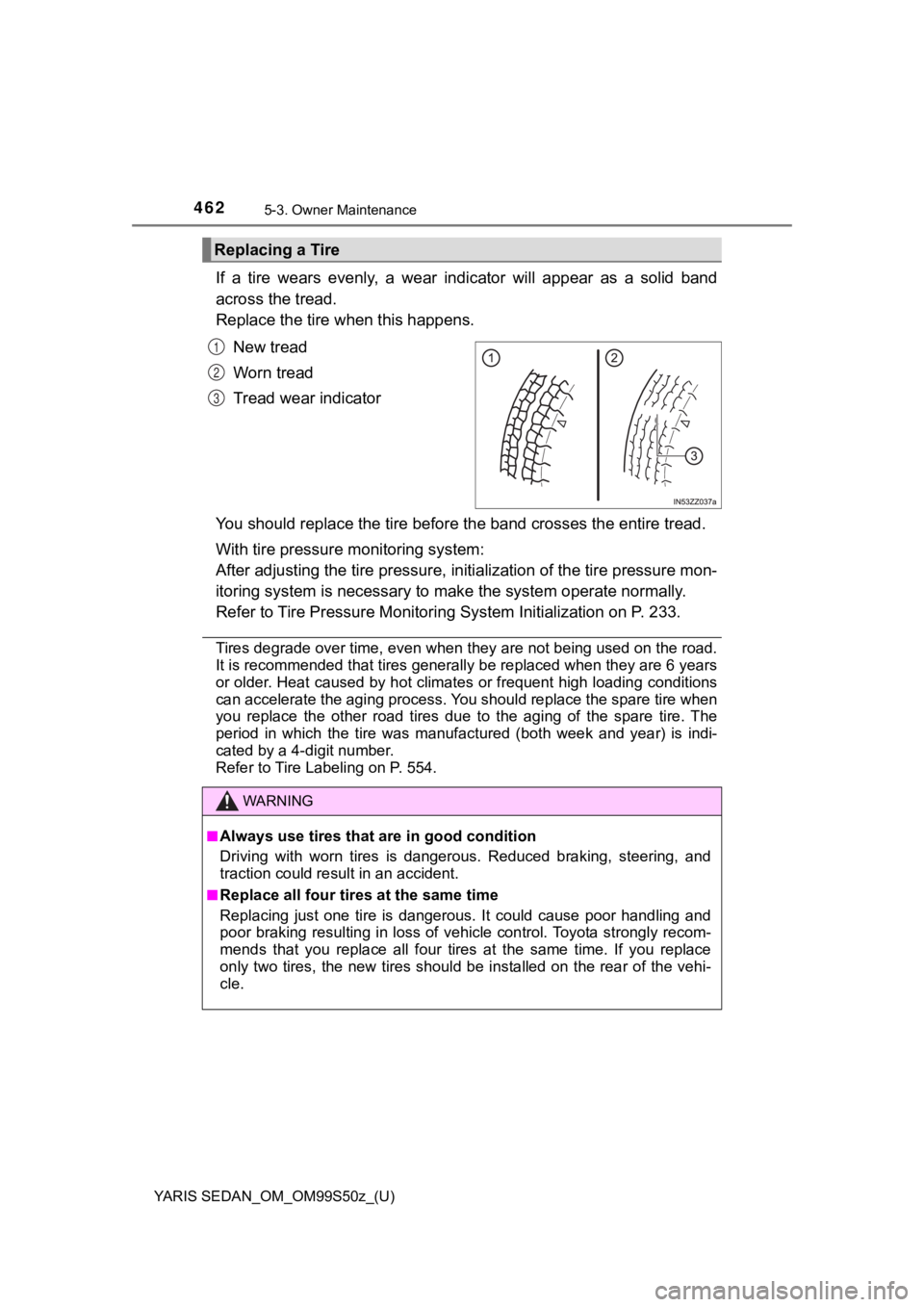
4625-3. Owner Maintenance
YARIS SEDAN_OM_OM99S50z_(U)
If a tire wears evenly, a wear indicator will appear as a solid band
across the tread.
Replace the tire when this happens.New tread
Worn tread
Tread wear indicator
You should replace the tire bef ore the band crosses the entire tread.
With tire pressure monitoring system:
After adjusting the tire pressur e, initialization of the tire p ressure mon-
itoring system is necessary to m ake the system operate normally .
Refer to Tire Pressure Monitorin g System Initialization on P. 233.
Tires degrade over time, even wh en they are not being used on the road.
It is recommended that tires gen erally be replaced when they are 6 years
or older. Heat caused by hot climates or frequent high loading conditions
can accelerate the aging process. You should replace the spare tire when
you replace the other road tires due to the aging of the spare tire. The
period in which the tire was manufactured (both week and year) is indi-
cated by a 4-digit number.
Refer to Tire Labeling on P. 554.
Replacing a Tire
1
2
3
WARNING
■Always use tires that are in good condition
Driving with worn tires is dangero us. Reduced braking, steering, and
traction could result in an accident.
■Replace all four tires at the same time
Replacing just one tire is dangerous. It could cause poor handl ing and
poor braking resulting in loss of vehicle control. Toyota strongly recom-
mends that you replace all four tires at the same time. If you replace
only two tires, the new tires should be installed on the rear o f the vehi-
cle.
Page 463 of 600
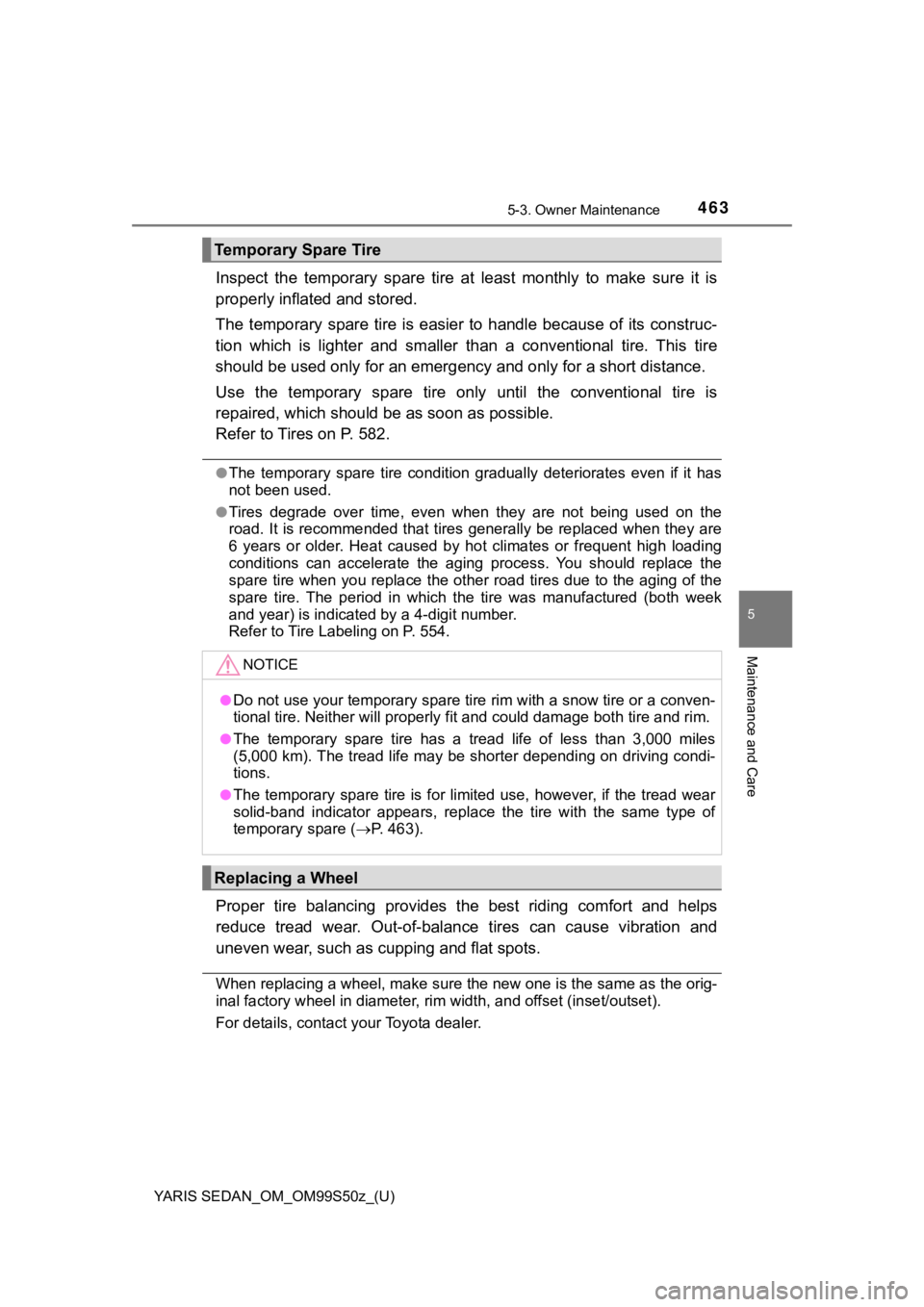
YARIS SEDAN_OM_OM99S50z_(U)
4635-3. Owner Maintenance
5
Maintenance and Care
Inspect the temporary spare tire at least monthly to make sure it is
properly inflated and stored.
The temporary spare tire is easier to handle because of its con struc-
tion which is lighter and smaller than a conventional tire. Thi s tire
should be used only for an emergency and only for a short dista nce.
Use the temporary spare tire o nly until the conventional tire is
repaired, which should be as soon as possible.
Refer to Tires on P. 582.
●The temporary spare tire condition gradually deteriorates even if it has
not been used.
●Tires degrade over time, even when they are not being used on t he
road. It is recommended that tires generally be replaced when t hey are
6 years or older. Heat caused by hot climates or frequent high loading
conditions can accelerate the aging process. You should replace the
spare tire when you replace the other road tires due to the agi ng of the
spare tire. The period in which the tire was manufactured (both week
and year) is indicated by a 4-digit number.
Refer to Tire Labeling on P. 554.
Proper tire balancing provides t he best riding comfort and help s
reduce tread wear. Out-of-balance tires can cause vibration and
uneven wear, such as c upping and flat spots.
When replacing a wheel, make sure the new one is the same as th e orig-
inal factory wheel in diameter, rim width, and offset (inset/outset).
For details, contact your Toyota dealer.
Temporary Spare Tire
NOTICE
●Do not use your temporary spare tire rim with a snow tire or a conven-
tional tire. Neither will properly fit and could damage both tire and rim.
●The temporary spare tire has a tread life of less than 3,000 mi les
(5,000 km). The tread life may be shorter depending on driving condi-
tions.
●The temporary spare tire is for limited use, however, if the tr ead wear
solid-band indicator appears, replace the tire with the same ty pe of
temporary spare ( P. 463).
Replacing a Wheel